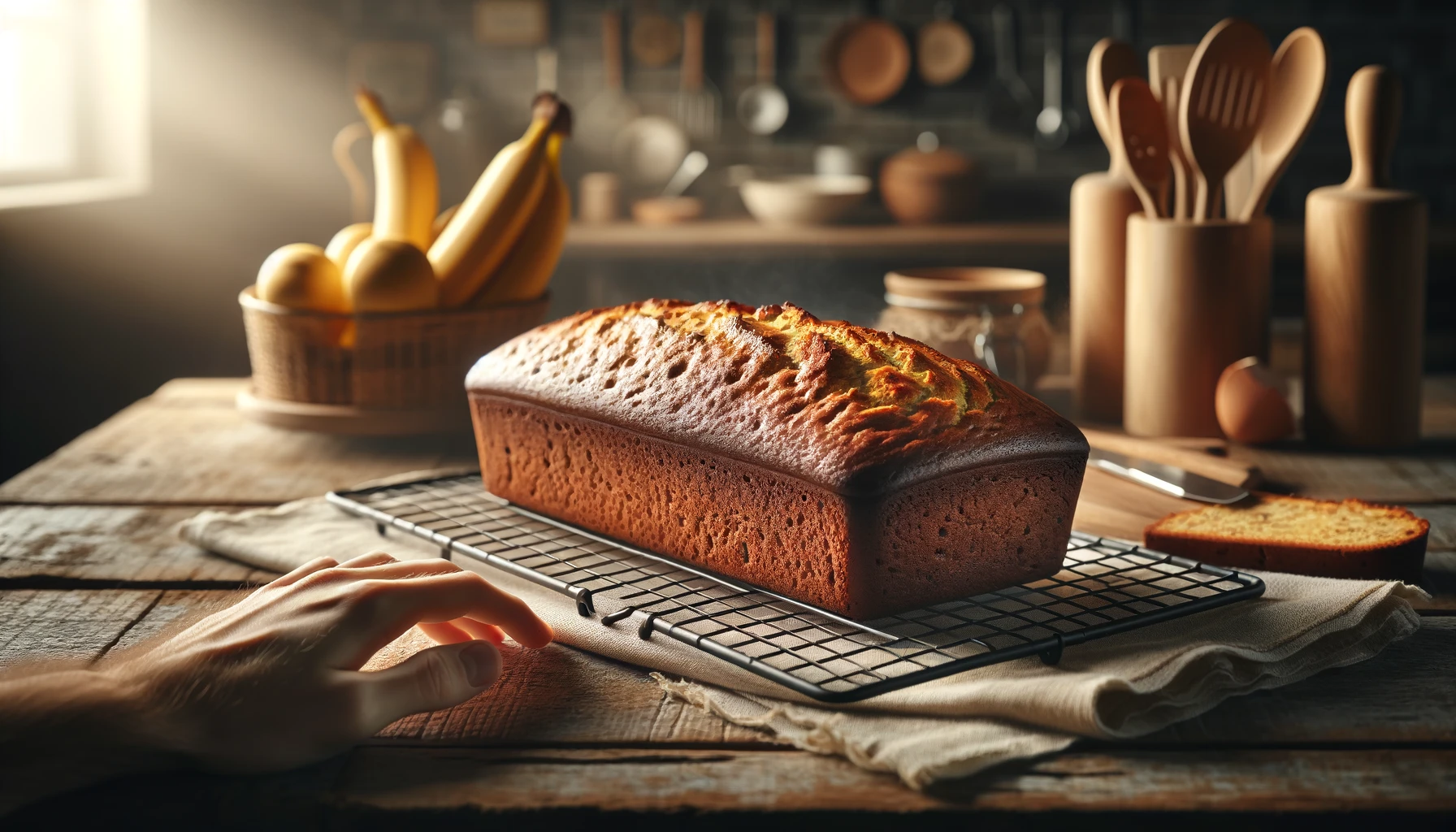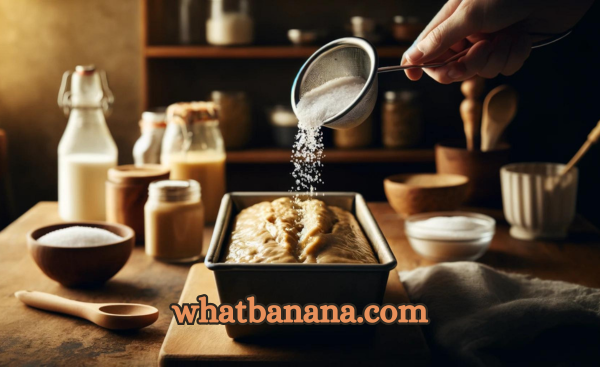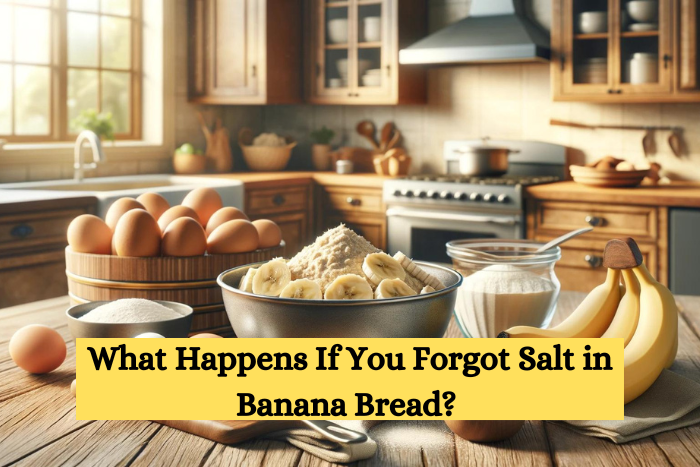It’s a mistake we could easily make, and leads us to wonder, what happens if you forget salt in banana bread?
After all, banana bread is meant to be sweet; why do we need salt anyway?
What does the salt do?
Will the lack of salt in the banana loaf change the taste or texture?
We had better find out the answers to these salty questions!
Forgetting salt in banana bread impacts flavor and texture. Salt enhances sweetness, balances flavors, and helps gluten structure. Without it, your banana bread may taste bland and have a denser, less appealing texture. Always include a pinch of salt for the best results.
Is Salt Necessary in Banana Bread?
Cooking is undoubtedly a science, and if a recipe requires a specific ingredient, there must be a reason.
But why do we need to put salt in a sweet dish such as banana bread?
Perhaps you may be thinking that salt is necessary to enable a chemical reaction in the cooking process.
That’s not the case at all, as banana bread doesn’t need the use of yeast to rise.
If you were baking yeast-based bread, then the salt would be an essential ingredient, as it slows down the fermentation process.
If you forget the salt in bread that uses yeast, it will rise too quickly and not cook properly.
However, when it comes to banana bread, salt is only necessary to add flavor.
Surprisingly, it enhances the sweetness of the bananas.
Overall, the loaf has more depth in its taste, and yet, you can’t detect the salt.
Perhaps you should try this, purposely omit the salt in the banana bread, as an experiment.
If you need to go on a low-sodium diet, this could be the start of re-educating your tastebuds.
The salt is also said to help with the browning of the banana bread.

What Are the Different Ingredients For in Banana Bread?
On the face of it, banana bread seems to be a simple recipe, but what do all the different ingredients do?
We have already established that salt is just for flavor; let’s look at the other necessities.
Flour is required to add structure to the banana bread.
It is possible to make banana bread without flour, which is good news for those with gluten intolerance.
The flour will need to be substituted for something such as rolled oats or oatmeal.

Baking soda is required for banana bread, as this is what causes it to rise.
It’s known as a leavening agent and needs an acidic liquid to activate it.
This could be buttermilk, sour cream, brown sugar, or molasses.
Baking powder is also a leavening ingredient and can be used in place of baking soda, or a mix of the two can be used.
Sugar adds sweetness, and you can use light brown or granulated.
Granulated sugar will produce a better golden brown color to the banana bread.
Butter gives extra lift to the banana bread when creamed with sugar.
It’s a personal preference as to whether you prefer salted or unsalted butter.
Eggs are the final essential ingredient for banana bread.
The egg white contains protein which will help give the loaf its structure when mixed with the flour.
The egg yolk adds flavor and creates a softer texture.
🍌 Common Banana Bread Mistakes🍞 |
|
|---|---|
| 🚫 Forgetting Salt | Leads to bland flavor and dense texture. |
| 🔄 Overmixing Batter | Results in tough, chewy bread. |
| 🥚 Incorrect Egg Temperature | Cold eggs can cause uneven baking. |
| 🌡️ Baking at Wrong Temperature | Too high or too low affects rise and texture. |
| Brought to You by whatbanana.com 🍌 | |
The Surprising Role of Salt in Baking
When you forget salt in banana bread, you might think it’s just a minor slip-up, but this small ingredient packs a big punch. Salt plays an essential role in balancing flavors and enhancing the overall taste of baked goods.
Without it, your banana bread can taste flat and one-dimensional, as salt helps to bring out the natural sweetness of the bananas and other ingredients. Moreover, salt impacts the texture and structure of your bread.
It strengthens gluten, which affects the chewiness and rise of the final product. In its absence, your bread might be denser and less flavorful.
Additionally, salt regulates yeast activity in recipes that include it, ensuring your bread doesn’t over-rise and collapse. Even in quick breads like banana bread, which doesn’t use yeast, salt can still make a noticeable difference in how the flavors meld together.
So next time you’re baking banana bread, remember that a pinch of salt is not just a seasoning but a crucial component that brings out the best in your baking. Forgetting it might not ruin your loaf, but including it will elevate your banana bread from good to great.
Banana Bread Problems
Final Thoughts
- Enhances Sweetness: Just like adding a pinch of salt to watermelon makes it sweeter, including salt in banana bread amplifies the natural sweetness of the bananas.
- Balances Flavors: Similar to how a dash of salt can improve the taste of chocolate, it balances the overall flavors in banana bread, preventing it from tasting overly bland.
- Improves Texture: Without salt, your bread could end up dense and heavy, much like a loaf of bread that hasn’t risen properly due to incorrect ingredients.
- Gluten Strength: Think of making pasta; adding salt to the water helps the pasta hold its shape.
- Baking Consistency: Skipping salt can result in inconsistent baking results, akin to how cookies without salt might spread too much or not rise enough, leading to a less desirable texture.
Salt is typically included in a banana bread recipe, but it’s not a necessity.
If salt is forgotten or purposely omitted from banana bread, then the resulting loaf will have less flavor.
Salt brings out the sweetness of the bananas and adds more depth to the taste.
Other ingredients, such as flour, can be substituted with something else if required.
However, a leavening agent is always required to help the banana bread to rise.
So, don’t panic; if you forget the salt in your banana bread, you might even prefer a different taste!
And on a similar subject, find out what I think about using salted butter for your banana loaf.
How do you think the small addition of salt changes the overall taste and texture of your favorite baked goods, and have you ever noticed a difference when you’ve accidentally left it out? Let me know in the comments below!

FAQ
1. What happens if you forget to add salt to banana bread?
- Without salt, banana bread can taste bland because salt enhances the natural sweetness and overall flavor balance.
- The texture may also suffer, resulting in a denser, less fluffy loaf since salt helps strengthen gluten structure.
2. Is salt necessary in banana bread?
- Yes, salt is necessary as it enhances flavors, making the bread taste richer and more complex.
- It also helps with the bread’s texture, contributing to a better rise and overall structure.
3. Can you add salt to banana bread after baking?
- Adding salt after baking won’t fully integrate into the bread, but you can sprinkle a little on top to enhance flavor.
- For best results, mix a pinch of salt into the butter you spread on the banana bread slices to get a balanced taste.
4. How much salt should I add to banana bread?
- Typically, recipes call for about 1/4 to 1/2 teaspoon of salt, depending on the size of the loaf and personal taste preferences.
- Adjust based on the recipe you’re using and your flavor preference, but avoid over-salting to prevent an overpowering taste.
- Forgot Salt in Your Banana Bread? Here’s What You Need to Know

- Taste the Difference: Unforgettable Dishes with Banana Leaves

- How to Prepare Banana Leaves for Pasteles? (Tips and Tricks!)

- Do Banana Leaves Need to Be Refrigerated? (The Answer May Surprise You!)

- Why Are My Banana Fritters Sticking? (A Look at the Facts!)

- Crumbly Banana Bread? Here’s How to Make It Moist and Perfect

